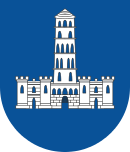
The national flag of Croatia or The Tricolour is one of the state symbols of Croatia. It consists of three equal size, horizontal stripes in colours red, white and blue. In the middle is the coat of arms of Croatia.

The coat of arms of the Republic of Croatia consists of one main shield and five smaller shields which form a crown over the main shield. The main coat of arms is a checkerboard (chequy) that consists of 13 red and 12 white fields. It is also informally known in Croatian as šahovnica. The five smaller shields represent five different historical regions within Croatia.

The coat of arms of Bosnia and Herzegovina was adopted in 1998, replacing the previous design that had been in use since 1992 when Bosnia and Herzegovina gained independence. It follows the design of the national flag. The three pointed shield is used to symbolize the three major ethnic groups of Bosnia, as well as allude to the shape of the country.

The Cuban coat of arms is the official heraldic symbol of Cuba. It consists of a shield, in front of a fasces crowned by the Phrygian cap, all supported by an oak branch on one side and a laurel wreath on the other. The coat of arms was created by Miguel Teurbe Tolón and was adopted on April 24, 1906.
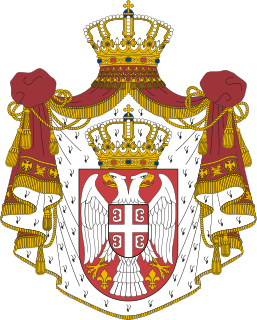
The coat of arms of Serbia is the official coat of arms of the Republic of Serbia. It is closely modelled after the royal coat of arms of the Kingdom of Serbia, and it was officially adopted by the National Assembly in 2004 and later slightly redesigned in 2010. The coat of arms consists of two main heraldic symbols which represent the national identity of the Serbian people across the centuries, the Serbian eagle and the Serbian cross.

The Slovene coat of arms consists of a red bordered blue shield on which there is a stylised white Mount Triglav, under which there are two wavy lines representing the sea and the rivers of the country. Above Mount Triglav, there are three golden six-pointed stars representing the Counts of Celje. It was designed in 1991 by Marko Pogačnik and adopted on 24 June 1991.
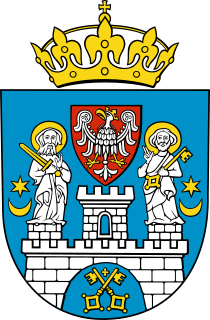
The coat of arms of Poznań consists of white city walls with three towers. On the left (heraldic) tower stands Saint Peter with a key and on the heraldic right one stands Saint Paul with a sword. In the gate there are two golden crossed keys with a cross above. Over the middle tower, which contains a single window and is topped by a battlement, there is a gothic shield with a white eagle in crown. On the sides of the two saints there are golden crescents and stars. All of those elements are on a blue field. Over the shield there is golden crown. Author of modern version of coat of arms is Jerzy Bąk.

Diocletian's Palace is an ancient palace built for the Roman emperor Diocletian at the turn of the fourth century AD, which today forms about half the old town of Split, Croatia. While it is referred to as a "palace" because of its intended use as the retirement residence of Diocletian, the term can be misleading as the structure is massive and more resembles a large fortress: about half of it was for Diocletian's personal use, and the rest housed the military garrison.

The coat of arms of Portugal is the main heraldic insignia of Portugal. The present model was officially adopted on 30 June 1911, along with the present model of the Flag of Portugal. It is based on the coat of arms used by the Portuguese Kingdom since the Middle Ages. The coat of arms of Portugal is popularly referred as the Quinas.

The Serbian eagle is a double-headed heraldic eagle, a common symbol in the history of Serbian heraldry and vexillology. The double-headed eagle and the Serbian cross are the main heraldic symbols which represent the national identity of the Serbian people across the centuries. It originated from the medieval Nemanjić dynasty. The eagle, defaced with the cross, has been used in the contemporary design of the coat of arms of Serbia following the tradition established by the Kingdom of Serbia in 1882.

The coat of arms of Dalmatia is the heraldic symbol used for the historical region of Dalmatia on the eastern coast of Adriatic Sea. It is also featured on the crest of the coat of arms of Croatia.

Split is Croatia's second-largest city and the largest city in the Dalmatia region. It lies on the eastern shore of the Adriatic Sea and is spread over a central peninsula and its surroundings. An intraregional transport hub and popular tourist destination, the city is linked to the Adriatic islands and the Apennine peninsula.

The Cathedral of Saint Domnius, known locally as the Sveti Dujam or colloquially Sveti Duje, is the Catholic cathedral in Split, Croatia. The cathedral is the seat of the Archdiocese of Split-Makarska, headed by Archbishop Marin Barišić. The Cathedral of St. Domnius is a complex of a church, formed from an Imperial Roman mausoleum, with a bell tower; strictly the church is dedicated to the Virgin Mary, and the bell tower to Saint Domnius. Together they form the Cathedral of St. Domnius.

The use of heraldry in Serbia or by Serbs is used by government bodies, subdivisions of the national government, organizations, corporations and by families. Serbian heraldry belongs culturally to the Byzantine tradition.

The emblem of Yugoslavia featured six torches, surrounded by wheat with a red star at its top, and burning together in one flame; this represented the brotherhood and unity of the six federal republics forming Yugoslavia: Bosnia and Herzegovina, Croatia, Macedonia, Montenegro, Serbia and Slovenia. The date imprinted was 29 November 1943, the day the Anti-Fascist Council for the National Liberation of Yugoslavia (AVNOJ) met in Jajce on its second meeting and formed the basis for post-war organisation of the country, establishing a federal republic. This day was celebrated as Republic Day after the establishment of the republic. The emblem of Yugoslavia, along with those of its constituent republics, are an example of socialist heraldry.
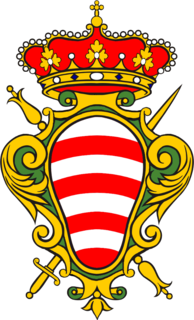
The Coat of arms of the Republic of Ragusa was the heraldic symbol of the historical Republic of Ragusa. It is today used in a variant for the city of Dubrovnik, Croatia. Its basic appearance is based on the coat of arms of the Árpád dynasty.
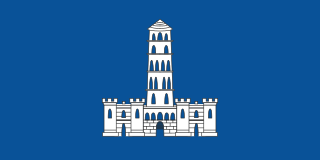
The Flag of Split is the vexillologic symbol of the city of Split. The flag is blue, with a shade gradient from darker to lighter from bottom to top, with the white emblem of the city in the lower half, consisting of six words "SPLIT" forming the silhouette of Diocletian's Palace and the Saint Domnius Cathedral belfry topped with a cross.
The following is a timeline of the history of the city of Split, Croatia.
The city of Split was founded as the Greek colony of Aspálathos (Aσπάλαθος) in the 3rd or 2nd century BC. It became a prominent settlement around 650 CE when it succeeded the ancient capital of the Roman province of Dalmatia, Salona. After the Sack of Salona by the Avars and Slavs, the fortified Palace of Diocletian was settled by the Roman refugees. Split became a Byzantine city, to later gradually drift into the sphere of the Republic of Venice and the Kingdom of Croatia, with the Byzantines retaining nominal suzerainty. For much of the High and Late Middle Ages, Split enjoyed autonomy as a free city, caught in the middle of a struggle between Venice and the King of Hungary for control over the Dalmatian cities.

The Iron Gate, Latin: Porta ferrea), or "the western gate" is one of the four principal Roman gates into the stari grad of Split that was once Diocletian's Palace. Originally a military gate from which troops entered the complex, the gate is the only one to have remained in continuous use to the present day.


